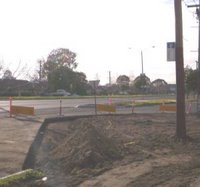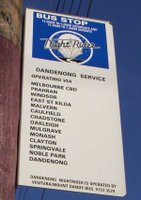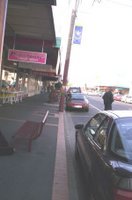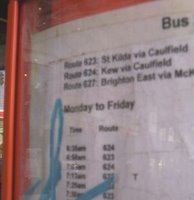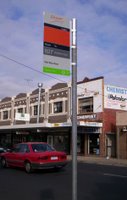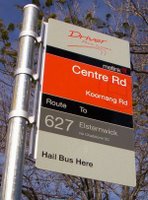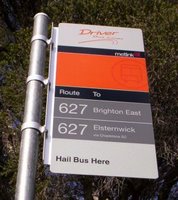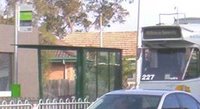When does walking beat buses?
It's a decision nearly every passenger who doesn't live next to a railway station has to face; is it quicker to walk home or wait for the bus?
The calculation is particularly important for Melbourne because though a minority of people live within 1km of a railway station, most of the rest live within 5km of one. To a large extent patronage growth depends on the abilty to attract new passengers from this 1 to 5 km belt.
There will be a distance below which walking is always quicker and is the preferred access mode. Planners call this the primary pedshed. This will be within about 400 metres of stops or station entrances. Walking is usually also fastest within a secondary pedshed, or up to about 800 metres from entrances.
At very long distances (eg 10km) the bus will always be quicker, even if the passenger has just missed one and needs to wait for the next one.
As explained before, it is the in between distances that are most crucial to patronage growth. The answers here are not clear cut, as it is not possible to determine which is faster without consulting timetables and making some estimates.
I will call the distance above which the bus is faster than walking the critical distance. This will vary according to factors like travel speed, distance, and for the bus, waiting times. The latter is set by service frequency or co-ordination and any late running caused by other traffic.
Let us assume a walking speed of 5km/h. For simplicity, we'll assume that the bus' speed is infinite. This will skew the numbers towards the bus, but only reinforces the main point that on local routes speed is worthless without frequency.
The following table shows how the critical distance is inversely proportional to service frequency, but can be made a small and constant amount with timed transfers.
Wm | Wavg | Dcrit (Wm) | Dcrit (Wavg) | Dcrit (Wco)
120 min ----- 60 min ----- 10 km ----- 5 km ----- 0.83 km
60 min ----- 30 min ----- 5 km ----- 2.5 km ----- 0.83 km
40 min ----- 20 min ----- 3.3 km ----- 1.66 km ----- 0.83 km
30 min ----- 15 min ----- 2.5 km ----- 1.25 km ----- 0.83 km
20 min ----- 10 min ----- 1.66 km ----- 0.83 km ----- 0.83 km
15 min ----- 7.5 min ----- 1.25 km ----- 0.62 km ----- 0.83 km
10 min ----- 5 min ----- 0.83 km ----- 0.42 km ----- n/a
Wm = max wait (service frequency)
Wavg = average wait (assuming random arrival)
Dcrit (Wm) = maximum critical distance
Dcrit (Wavg) = average critical distance
Dcrit (Wco) = critical distance co-ordinated services (10 min wait)
What does the table mean? If the bus runs every hour and one has just been missed, then walking is faster than waiting in all areas up to 5km from the station. This is the 'worst case' example; a critical distance of 2.5 kilometres (assuming a random arrival at the bus stop) is more representative where services are unco-ordinated (as in Melbourne).
This gap between the station's pedshed (800 metres) and the critical distance (in this case 2500 metres) represents those areas that could potentially benefit from the train, but cannot since feeder buses are ineffective and the station is beyond walking distance*. The bigger the gap, the more people miss out, and the smaller the gap the greater the station's catchment area and thus potential patronage.
Ideally the critical distance should equal the pedshed so that there is no gap at all. With an 800 metre pedshed, this situation is reached when service frequency is every 10 minutes. Assuming the worst case (bus just misses the train) the maximum wait is the same as the pedshed distance and the average is much less.
Where a 10 minute frequency cannot be achieved, the critical distance can still be lowered greatly by harmonising headways and carefully co-ordinating timetables. In this way every second train will have a good connection with the bus so people can plan a shorter journey time if they so wish. Even with a generous 10 minute connection time the difference between the pedshed and the critical distance reduces to insignificant proportions.
Hence a transfer time of 10 minutes is probably acceptable though not seamless. With improved pedestrian access to bus stops and stricter timed transfer arrangements (eg 4-5 minute connections) the critical distance could be lowered to 400 or even 300 metres. Such a reduction would most benefit activity centres that are slightly away from the railway station but becomes less important for low-density residential areas.
What conclusions can be drawn? The first is that there are currently large gaps between station pedsheds and critical distances. This creates large 'donuts' immediately outside station pedsheds where both walking and bus access to the station can be considered poor (especially when compared to driving).
Secondly, these poorly served donuts contain huge populations. If 20% of people live within station pedsheds, assuming 20 to 30% more (ie 600,000 to 900,000 people) just outside is not unreasonable.
As a result a strategy to fix transport beyond the pedshed by introducing Perth-style bus-train route and service co-ordination is likely to boost patronage, achieve modal share goals and improve utilisation of a largely empty bus fleet.
(*) It should not be overlooked that there is also such thing as a 'bikeshed', with a distance of around 2000 metres. Bike + train is almost certainly faster than bus + train without service co-ordination. However due to crowding, it is unwise to encourage bicycles on 'normal flow' peak hour trains. The alternative of using bicycle lockers at stations helps some, but if the destination is beyond the station's pedshed then the lack of a bike reduces ease of access. This gets back to improving bus access as described above.
